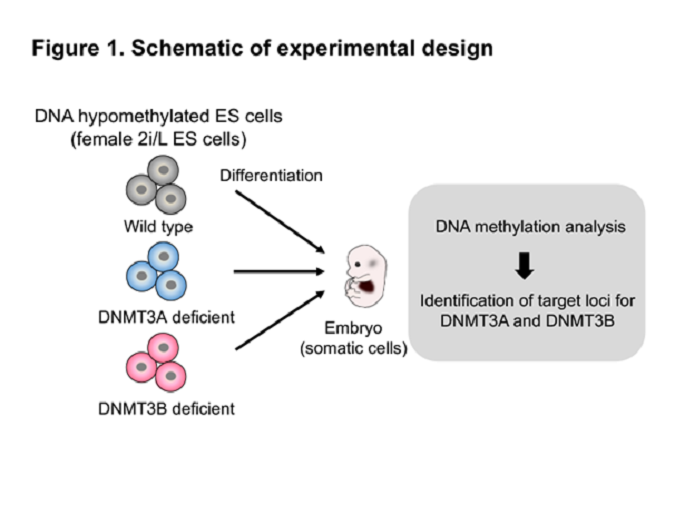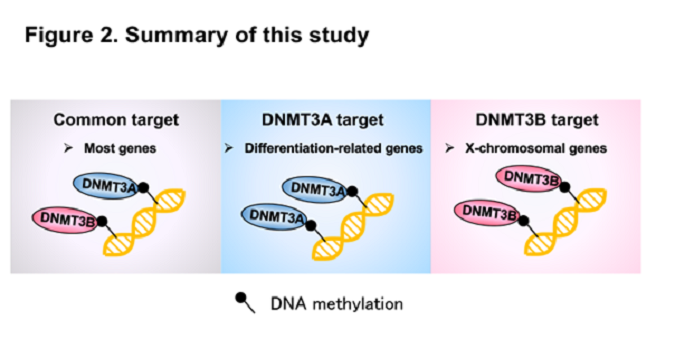Identification of distinct loci for de novo DNA methylation by DNMT3A and DNMT3B during mammalian development
Identification of distinct loci for de novo DNA methylation by DNMT3A and DNMT3B during mammalian development.
Nature Communications on June 24, 2020. DOI:10.1038/s41467-020-16989-w
DNA methylation (*1) performs an essential function in mammalian ontogeny. It is also known that abnormalities in this process cause the development of cancers such as leukemia.
A research team working at The University of Tokyo and Kyoto University in Japan has announced that they have successfully identified specific target sites for the DNA methylases DNMT3A and DNMT3B (*2 ).
The researchers also found that DNMT3A specifically regulates differentiation-related genes and DNMT3B specifically regulates X-chromosomal genes during mammalian ontogeny. These results were published in Nature Communications (online version).
“ The results will lead to the elucidation of the regulatory mechanism of DNA methylation during the mammalian developmental process and also lead to a more detailed understanding of the onset mechanism of cancer and other diseases caused by abnormal DNA methylation.,” said the principal investigator of this research, Professor Yasuhiro Yamada at the Division of Stem Cell Pathology, Center for Experimental Medicine and Systems Biology, The Institute of Medical Science, The University of Tokyo (IMSUT).


(*1 ) DNA methylation
A biological process by which methyl groups are added to the DNA molecule, which is important for regulation of gene expression.
(*2 ) DNA methylases DNMT3A and DNMT3B
DNMT3A and DNMT3B, encoded by the Dnmt3a and Dnmt3b genes, respectively, function in establishing DNA methylation patterns during embryogenesis. Mutations at Dnmt3a and Dnmt3b cause various diseases, including cancers and immune disorders.
A research team working at The University of Tokyo and Kyoto University in Japan has announced that they have successfully identified specific target sites for the DNA methylases DNMT3A and DNMT3B (*2 ).
The researchers also found that DNMT3A specifically regulates differentiation-related genes and DNMT3B specifically regulates X-chromosomal genes during mammalian ontogeny. These results were published in Nature Communications (online version).
“ The results will lead to the elucidation of the regulatory mechanism of DNA methylation during the mammalian developmental process and also lead to a more detailed understanding of the onset mechanism of cancer and other diseases caused by abnormal DNA methylation.,” said the principal investigator of this research, Professor Yasuhiro Yamada at the Division of Stem Cell Pathology, Center for Experimental Medicine and Systems Biology, The Institute of Medical Science, The University of Tokyo (IMSUT).


(*1 ) DNA methylation
A biological process by which methyl groups are added to the DNA molecule, which is important for regulation of gene expression.
(*2 ) DNA methylases DNMT3A and DNMT3B
DNMT3A and DNMT3B, encoded by the Dnmt3a and Dnmt3b genes, respectively, function in establishing DNA methylation patterns during embryogenesis. Mutations at Dnmt3a and Dnmt3b cause various diseases, including cancers and immune disorders.
Learn more at Press Release.
